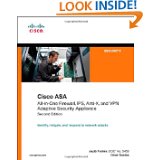I am off and running – wohoo! For today’s reading, I enjoyed the appropriate sections of the ASA All In One text from Cisco Press.
For lab work – I read the CCNP Security Lab Workbook from ACIT.in. I then created my own lab allowing me to practice a similar set of exercises in GNS3.
In this first objective – we just need to be able to FLY through the basic configurations on an ASA interface. Remember, these interfaces possess names and security levels. Remember also that we are going to ping from the ASA to verify connectivity. We cannot, be default, ping through the ASA.
Here we go:
ciscoasa(config)# hostname ASA1 ASA1(config)# interface gi0 ASA1(config-if)# nameif outside INFO: Security level for "outside" set to 0 by default. ASA1(config-if)# ip address 200.1.30.254 255.255.255.0 ASA1(config-if)# no shut ASA1(config-if)# ping 200.1.30.3 Type escape sequence to abort. Sending 5, 100-byte ICMP Echos to 200.1.30.3, timeout is 2 seconds: !!!!! Success rate is 100 percent (5/5), round-trip min/avg/max = 10/18/50 ms ASA1(config-if)# interface gi1 ASA1(config-if)# nameif inside INFO: Security level for "inside" set to 100 by default. ASA1(config-if)# ip address 200.1.10.254 255.255.255.0 ASA1(config-if)# no shut ASA1(config-if)# ping 200.1.10.1 Type escape sequence to abort. Sending 5, 100-byte ICMP Echos to 200.1.10.1, timeout is 2 seconds: !!!!! Success rate is 100 percent (5/5), round-trip min/avg/max = 10/20/60 ms ASA1(config-if)# interface gi2 ASA1(config-if)# nameif DMZ INFO: Security level for "DMZ" set to 0 by default. ASA1(config-if)# security-level 50 ASA1(config-if)# ip address 200.1.20.254 255.255.255.0 ASA1(config-if)# no shut ASA1(config-if)# ping 200.1.20.2 Type escape sequence to abort. Sending 5, 100-byte ICMP Echos to 200.1.20.2, timeout is 2 seconds: !!!!! Success rate is 100 percent (5/5), round-trip min/avg/max = 10/16/40 ms ASA1(config-if)# wr Building configuration... Cryptochecksum: d785382c b71ac6aa 74d5b0f8 0a2ef12d
This sure was fun! I guess because it was so easy right?!?! CCNA Security stuff here. Now for a quick review of how the security levels work on the ASA. A device on the INSIDE should be able to Telnet to a device on the OUTSIDE, but the opposite should not be true. Let’s try it:
R1#telnet 200.1.30.3 Trying 200.1.30.3 ... Open User Access Verification Password: R3>exit
R3#telnet 200.1.10.1 Trying 200.1.10.1 ... % Connection timed out; remote host not responding
Perfect! The ASA is functioning just as we would suspect. Questions – comments – use the area below!


Yes right because ASA doesn’t allow lower security level network to come into higher security area …
So,outside network can not reach inside without ACL but ,inside can go and connect outside world because it has security level 100
Yes – excellent! We see the name outside get a 0 security level and inside get a 100. Water cannot flow from a low point to a high point – so access is not permitted from the low number to the high number.
Good start! Keep it coming!!!
Looks like I’m getting a new book 😉
You will love it! There is a focus on the GUI – but then they wisely provide the CLI output as well. I am going to stick to the CLI again when configuring the ASA devices in the lab.